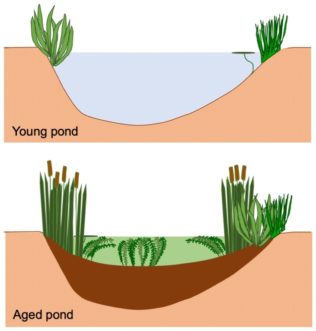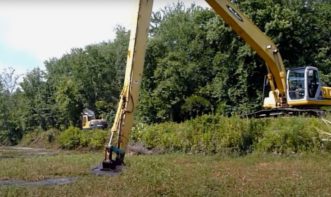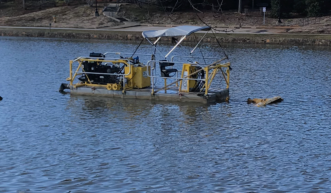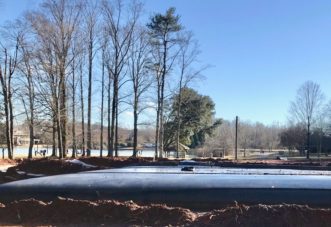Dredging is often one of the larger projects a pond owner may consider; successful projects require careful planning and frequently involve hiring a professional experienced in planning, permitting, and completing similar work. This publication provides an overview of dredging considerations for recreational and farm ponds and is intended to inform pond owners, professional pond managers, and water resource professionals. The scope of this publication is limited to returning a farm or recreational pond to original water storage capacity design conditions by removing non-contaminated sediment. Additional regulations likely apply to projects that expand, modify, or repair a pond; dredge within stormwater or industrial ponds; or if contamination is present or suspected of being present.
Overview

Figure 1. Over time, ponds typically accumulate sediment and abundant plant growth. Image credit: Sarah White, Clemson University.
Ponds that receive streamflow or stormwater runoff capture sediment over time, which can significantly change conditions in the pond. The water depth and photic zone (where sunlight penetrates to the bottom of the pond) become shallower with increased sedimentation, and the ambient water temperature may increase, especially during warmer months (figure 1). Additionally, nutrient-rich sediment can become an internal source of nutrient loading.1 Combined, these conditions often result in an increase in aquatic plant and algae growth, which may interfere with the intended use(s) of the pond and become difficult to control. For additional information on pond aging and water quality parameters, please see the Land-Grant Press publication “Recreational Ponds in South Carolina”.
When a pond no longer meets the intended use(s) due to excessive sedimentation (figure 2), a pond owner may need to physically remove the accumulated sediment through dredging to restore the original pond design parameters. Stormwater ponds are commonly designed to capture sediment, and regulations may dictate the sedimentation threshold that should trigger dredging. In recreational and farm ponds, voluntary dredging can return the original water storage capacity and remove an internal source of nutrients. Once a pond owner determines dredging is necessary to restore the intended use(s) of a pond, there are numerous factors to consider, which are outlined below.

Figure 2. Accumulated sediment is starting to form an upland peninsula in this pond. Image credit: Heather Nix, Clemson Cooperative Extension.
Considerations
A pond owner considering a dredging project to restore the intended use(s) of a pond should evaluate various factors such as potential benefits, costs, equipment needs and transport, water access, use of the pond, the ability to manage the pond’s water level during dredging, the volume of sediment that will be removed, available options for temporary storage of sediment for drying, available options for permanent storage or disposal of sediment, regulatory or permit requirements, the appropriateness of various best management practices, environmental impact minimization techniques, and potential impact to aquatic organisms.
Volume of Sediment
The volume of sediment to be removed and managed is a principal factor in determining dredging costs. Hiring a professional to measure sediment volume typically provides more accurate planning and cost-estimating results. Suppose the pond’s original design, or at least average depth, is known. In that case, a pond owner can calculate a rough estimate of the sediment volume by measuring the surface area of the pond and the current average water depth. The difference in those numbers yields the rough estimate of the current depth of sediment. Several such measurements in several different locations in the pond are recommended for developing this rough estimate. Sediment density, based on the type of soil(s) comprising the sediment and its compaction in the sediment bed, significantly impacts the volume of sediment, can vary widely, and is more challenging and expensive to measure.
Equipment Needs and Access
The method of sediment removal is another important factor in project cost. Dredging typically involves the use of large excavating equipment that must be transported to the pond. Many ponds are easily accessed from paved roads or driveways; however, upgrades to or installation of access roads may be needed for more remote ponds. The suitability of access roads, including width and slope, the weight-bearing capacity of all crossings (e.g., culverts, bridges), and the turning radii, should be carefully evaluated before initiating a dredging project.
Types of Dredging/Equipment

Figure 3. Mechanical dredging involves use of an excavator to scoop sediment from the pond bottom and place it outside of the pond. Image credit: Screenshot by author, YouTube video by letsdig18.
There are two main methods for dredging: mechanical and hydraulic. Mechanical dredging involves the use of an excavator to scoop sediment from the pond bottom and place it outside of the pond (figure 3). It is important to note that sediment, once removed, may not be returned to any waterbody unless authorized by a permit or specifically exempted (see “Materials Handling” section for additional information).2 Hydraulic dredging involves pumping sediment from the pond through a temporary tube or pipeline to an upland location outside of the pond (figure 4).3 If necessary, dredge spoils can be dewatered using various techniques, such as a sediment basin or geotextile tubes (figure 5).4
Waters of the United States (WOTUS): Navigable and Non-Navigable
Many recreational and farm ponds qualify as “waters of the United States” (WOTUS) and, as such, are subject to Clean Water Act (CWA) jurisdiction and associated federal regulations.5 The US Army Corps of Engineers (USACE) is responsible for making determinations regarding which waters are WOTUS and subject to CWA jurisdiction and for implementing some CWA regulatory programs. Generally, ponds that receive streamflow and/or discharge water downstream most of the year will likely be considered WOTUS and subject to regulation.
WOTUS is a broad category that includes both navigable and non-navigable water bodies. From both a federal and state standpoint, the navigable status of waters was defined at the time of statehood. For South Carolina, one of the original colonies, statehood was established in 1776. There were no dams in place at the time; thus, the current presence of a dam, which may practically limit actual navigation of a traditional navigable water, does not change or diminish the navigable status of that water. Generally, a water body that could float a log or canoe in 1776 is considered navigable water by the State definition, and waters that were or may be susceptible to use in interstate or foreign commerce are federal navigable waters. By and large, State and Federal defined navigable waters are the same. The SC Department of Health and Environmental Control (SCDHEC) has investigated navigable waters in the state, a large portion of which are depicted on a blue-lined map available online. It should be noted that this map is not comprehensive, and SCDHEC determines when the permitting jurisdiction of R.19-450, Permits for Construction in Navigable Waters, is applicable.
Non-navigable waters are also considered WOTUS if they flow either permanently or intermittently (also called seasonal or semi-permanent waters). Additionally, wetlands also qualify as WOTUS if they are abutting, adjacent to, or have a significant nexus to these waters (i.e., a chemical, physical, or biological connection exists individually or in combination between the water body and wetlands). Ephemeral waters, waters that only flow during rainfall events, and wetlands associated with ephemeral waters are not considered within the scope of the CWA. Thus, a pond would qualify as a WOTUS if it is connected through a channel, pipe, or other outfall to either a non-navigable permanent or semi-permanent stream or spring.
Permitting Overview
Section 404 of the CWA establishes a program to regulate and permit the discharge of dredged sediment into WOTUS, including navigable waters, non-navigable waters, and wetlands.6 Specific activities are exempted from permitting requirements, as described on the US Environmental Protection Agency’s (USEPA) website.
Pond dredging activities may result in the discharge of sediment to jurisdictional waters, and therefore a permit may be required. Any person contemplating dredging activities should first consult with the USACE to confirm if a Section 404 permit is required for the proposed dredging project. For projects within South Carolina, the USACE Charleston District’s Regulatory Program should be contacted prior to initiating a project to confirm if a permit is necessary.
Also, note that a project requiring a CWA Section 404 permit must first obtain a CWA Section 401 Water Quality Certification (WQC) from SCDHEC in order for the USACE to issue a permit. In some cases, CWA 401 WQCs are established by default based on and associated with the CWA Section 404 permitted impact.
Navigable and Non-Navigable WOTUS
If a waterbody is deemed navigable, dredging will require permits under Section 10 of the Rivers and Harbors Act of 1899 and under the CWA Section 404.
Permitting may be required for non-navigable WOTUS water bodies, including ponds; individuals are encouraged to contact the USACE for confirmation. Activities associated with ponds actively used for farming may qualify for an agricultural exemption from permitting.7 However, applicable USDA NRCS guidelines should be followed. Additional activities meeting strict requirements are also allowed without a permit. Specifically, for any non-navigable pond, if one can excavate sediment from the pond (typically via mechanical means, such as an excavator) and the sediment can be deposited directly to high ground (i.e., an upland area completely outside of WOTUS) with no side-casting, double handling, or temporary storage in a WOTUS, then such dredging is not regulated by the USACE, and a 404 permit or 401 WQC is not required. These restrictions significantly limit the possible scope of dredging to the reach of an excavator into the pond (from outside the pond boundaries), and the excavator must be positioned on high ground. For any such non-permitted activities, one cannot expand, enlarge, or deepen the pond beyond its original design limits.
Permit Options and Conditions
The USACE has several types of Section 404 permits that apply to these types of projects: Individual, Regional, and Nationwide. Individual Permits are for larger projects and require significant time and effort to obtain. SCDHEC also has a role in issuing General Certifications. For smaller, commonly completed projects that likely have a minimal or short-term adverse effect on the environment, the USACE developed Nationwide Permits (NWPs) that apply standard conditions to streamline the application and approval process.
Currently, numerous Nationwide Permit options are available for use within South Carolina, but most are not applicable to dredging. Nationwide Permit 18 Minor Discharges may be appropriate for pond dredging and may authorize projects involving redeposition of up to 25 cubic yards of sediment below the ordinary high-water mark.8 The USACE website includes general conditions that apply to projects authorized by any NWP, and a pre-construction notification may be required.
Potential permittees are encouraged to contact the USACE to confirm availability of a specific Nationwide Permit (NWP) and to request a pre-application meeting. The potential permittee should be well prepared and come to that meeting with their dredging plan; including, at a minimum, a tax map and/or survey of the property, an aerial photograph(s) of the pond and property, additional detailed photographs of the pond and specific areas where dredging is proposed, an estimated volume of sediment to be removed, the method anticipated for removal, and an annotated map and photographs showing the location planned for deposition of the removed sediment. With this information, the USACE representative may provide a letter exempting the activity from a 404 permit, provide alternatives to conduct the dredging activity more effectively, or recommend that you retain a professional to assist you in applying for a NWP.
Minimizing Impacts
Minimization of environmental impacts from dredging impoundments will fall into two categories, those dealing with the removal of sediments and those dealing with the disposal of dredged sediments.
Activities must minimize the migration of sediments to another location within the pond or another waterway. Examples of minimization practices include utilizing sediment control BMPs like turbidity curtains or performing dredging during periods of low water, low flow, no flow, or low tide conditions. In some cases, the water level of the impoundment may be lowered to allow preliminary dewatering of the sediment and allow equipment to access the sediment more easily. In all cases, the desire is to prevent release of sediment. Placement, or intentional movement, of any dredged sediment within a WOTUS typically requires federal and state permits. As sediment is removed, it should be placed outside of all water bodies. Any associated drainage and stormwater runoff should not be allowed to flow directly to the pond or another waterway; best management practices may be required.
The dredged sediments must not be directly placed into any water bodies or wetlands unless specifically permitted or exempted. The sediment must be placed in upland areas, and any water draining from the dredged sediment should not be allowed to flow back into any water bodies, streams, or wetlands in an uncontrolled fashion. Double silt fencing is typically used to prevent migration of the dredged sediment if stockpiled. The dredged sediment should have a permanent vegetative cover established as soon as practicable using appropriate species according to the time of year to prevent erosion.
Coastal Zone
Special considerations may also apply for projects within South Carolina’s Coastal Zone, which includes the eight coastal counties of Beaufort, Berkeley, Charleston, Colleton, Dorchester, Georgetown, Horry, and Jasper. The SC General Assembly established the SC Coastal Zone Management Program in 1977 to direct regulation and permitting over projects with regard to four key areas of interest, including coastal waters, tidelands, beaches, and the beach/dune system.9
In addition, the SC Coastal Zone Management Program has certification powers over Federal and State programs for projects that may impact any coastal resources of the State. This Coastal Zone Consistency oversight and, when applicable, permitting is performed by the Ocean and Coastal Resource Management (OCRM) office in SCDHEC. For additional information regarding requirements for projects within SC’s Coastal Zone, please see the SCDHEC OCRM website.
Materials Handling
When removing sediment from a pond, appropriate erosion and sediment control procedures must be followed to ensure that the dredged sediment is not allowed to flow back into any waterbody. Best management practices (BMPs) may include silt fencing, temporary sediment basins, and geotextile logs.
Lowering a pond’s water level can allow the sediment to dewater naturally before removal from the pond. Dewatered materials should be placed directly into a permanent storage location, and a vegetative cover should be established quickly. Best practices typically encourage bare soils to be vegetated within two weeks.10 Ideally, permanent seeding should take place immediately if seasonal timing for the species is appropriate. Otherwise, temporary seeding may be required to stabilize the material until appropriate vegetation can be permanently established.
When dewatering the sediments in place is not possible, the material may need to be stockpiled in a temporary location to dry out before transport to a permanent storage location. The stockpiled materials must be placed in an upland area with appropriate BMPs to prevent sediment from moving into a waterbody. BMPs may include a silt fence and a temporary sediment basin to capture sediment from stormwater runoff. Once the material is dewatered, it may be moved to a permanent location, and vegetation should be established, as noted above.
Special Consideration for Disposal
This article assumes that dredged sediments are benign and non-contaminated. If contamination is present or suspected to be present, an environmental professional should be consulted prior to any movement of the dredged sediment. In these cases, regulators may require sampling and analysis, special disposal measures, and measures to prevent exposure to or spread of the contamination.
Summary
When a pond has significant sediment accumulation, dredging can restore original water storage capacity conditions and intended use(s). A dredging project should be carefully planned to avoid release of sediment back into the pond, downstream from the pond, or into another waterway. The USACE and SCDHEC should be consulted to ensure applicable permit requirements are met. Additionally, steps should be taken to stabilize any exposed soil to prevent erosion and reduce future sedimentation of waterways.
References Cited
- Hudson H. Lake notes: lake dredging. Chicago (IL): Northeastern Illinois Planning Commission. 1998. http://www.epa.state.il.us/water/conservation/lake-notes/lake-dredging/lake-dredging.pdf.
- 33 U.S.C §1344 – Permits for dredged or fill material. Washington (DC): United States Government. [accessed 2022 Mar]. https://www.law.cornell.edu/uscode/text/33/1344.
- An Owner’s Guide to Managing Dredging Projects. Kansas City (MO): Dredge America. [accessed 2022 Mar]. https://dredgeamerica.com/helpful-information/owners-guide/.
- Dredged Material Processing Technologies: Dewatering, Separation, Solidification and Ex Situ Treatment. Washington (DC): Federal Remediation Technologies Roundtable. [accessed 2022 Mar]. https://frtr.gov/matrix/Dredged-Material-Processing-Technologies/.
- 33 CFR Part 328 – Definition of waters of the United States. Washington (DC): US Environmental Protection Agency. [accessed 2022 Mar]. https://www.law.cornell.edu/cfr/text/33/part-328.
- Overview of Clean Water Act Section 404. Washington (DC): US Environmental Protection Agency. [accessed 2022 Mar]. https://www.epa.gov/cwa-404/overview-clean-water-act-section-404.
- Exemptions to Permit Requirements under CWA Section 404. Washington (DC): US Environmental Protection Agency. [accessed 2022 Mar]. https://www.epa.gov/cwa-404/exemptions-permit-requirements-under-cwa-section-404.
- Nationwide Permit 18 – Minor Discharges. Washington (DC): United States Army Corps of Engineers. [accessed 2022 Mar]. https://www.swt.usace.army.mil/Portals/41/docs/missions/regulatory/NationwidePermits/Nationwide%20Permit%2018%20-%20Minor%20Discharges.pdf?ver=2017-03-31-150712-863.
- The South Carolina Coastal Zone Management Program. Columbia (SC): SC Department of Health and Environmental Control. [accessed 2022 Mar]. https://scdhec.gov/environment/your-water-coast/ocean-coastal-resource-management/coastal-zone-management/south.
- SCDHEC. Storm water BMP field manual. Columbia (SC): SC Department of Health and Environmental Control. 2005 July [accessed 2022 Apr]. https://scdhec.gov/sites/default/files/docs/Environment/docs/OCRM_DHEC_FIELD_MANUAL.pdf.
Additional Resources
Nix HB, Beecher L, Davis RH. Recreational ponds in South Carolina. Clemson (SC): Clemson Cooperative Extension, Land-Grant Press by Clemson Extension; 2021 Oct. LGP 1125. https://lgpress.clemson.edu/publication/recreational-ponds-in-south-carolina/.
White SA, Beecher L, Davis RH, Nix HB, Sahoo D, Scaroni AE, Wallover CG. Ponds in South Carolina. Clemson (SC): Clemson Cooperative Extension, Land-Grant Press by Clemson Extension; 2021 Jul. LGP 1114. https://lgpress.clemson.edu/publication/ponds-in-south-carolina/.
Nix HB, Lunt S, Davis RH. Pond Weeds: Causes, Prevention, and Treatment Options. Clemson (SC): Clemson Cooperative Extension, Land-Grant Press by Clemson Extension; 2021 Dec. LGP 1126. https://lgpress.clemson.edu/publication/pond-weeds-causes-prevention-and-treatment-options/.



